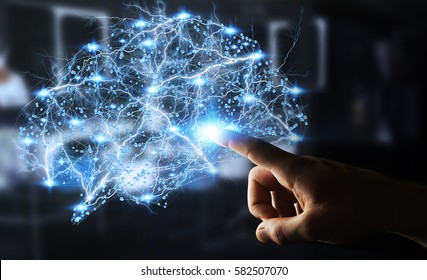Neural Networks In Control Systems
Authors: Atharva Karwande, Tejas Kolhe, Rushikesh Magar, Soham Kamble, Aboli Joshi.
The
necessary scheme of a Neural Network is to define interconnected units, also
called as “neuron”, where the connections have weights. The networks have some input features which
when passing through number of neurons, compute one or more outputs. There are
three fundamental blocks of a Neural Network.
- Input Layer
- Hidden Layers
- Output Layers
 |
| Fig 1. Different Components in a Neural Network |
With the
advent of time and computational capabilities of a computer, ANN has time and
again proved to be fruitful in prediction and control of systems. Various industries
find their roots of working in the correct implementation of optimized neural
networks. One the fields in which ANNs are being used exhaustively is Control.
There are
usually two steps involved while implementing a Neural Network for control
system:
- System Identification
- Control Design
System Identification
is the process of estimation or inference of the relationship between the input
and outputs. This is usually same for all the types of Neural Network
Architecture. But the second stage i.e. Control Design varies drastically.
System Identification deals with developing a neural network model for the
plant we want to control. Design Control stage uses the neural network
developed to design a controller that controls the plant.
There are
three major Neural Network Architectures used:
- Model Predictive Control.
- NARMA-L2 Control.
- Model Reference Control.
Let us
discuss each one in detail:
1. Model Predictive Control : The
neural networks for Model Predictive Control can be based on linear as well as
non-linear model predictive controller. We will be looking into the non linear
part of this.
- System Identification : As discussed above, the first stage on any control system neural network is the system identification. This part involves training the neural network to represent the forward dynamics of the plant to be controlled. The error between the predicted response and the actual response acts a neural network training signal. The following represents the process:
 |
Fig 2.
Block diagram of predictive model control [1]
|
- Predictive Control : In the model predictive control,
model predicts the plant responses over a time horizon. This method is called as receding horizon
technique. The training requires a batch algorithm for feed forward network.
This is really fast and is optimized. The neural network works to optimize the
cost function and then calculates the optimal input to the plant. This
controller requires an online optimization algorithm which can be
computationally expensive as after every lop the input is re optimized.
2. NARMA-L2 Control : It
is also regarded as feedback linearization control. It is referred to as so
when the plant model has a particular form. It is referred to as NARMA L2 when
the plant control can be approximated by the same form. The central design of
this type of controller is to alter non linear system dynamics into linear
system dynamics by removing the non linearity.
- System Identification : The first step as stated is to develop a model using the previous data of the plant. The NARMA-L2 approximation is given by,
y(k + d) = h[y(k), y(k – 1), ¼, y(k – n + 1), u(k), u(k – 1), ¼, u(k – m + 1)]
- NARMA-L2 Controller : The subsequent control input is determined to force the plant output to follow a reference signal. The plant model neural network is trained with static back propagation. The controller is basically rearrangement of the plant model system, and requires minimal online computation which is beneficial. And the same can be done in a single neural network.
3. Model Reference Controller : The third type of
Neural Network is Model Reference Control. This type of architecture uses two
nets.
- Plant Model Network.
- Controller Network.
 |
Fig 3. Block diagram of Model
Reference Control Architecture[1]
|
The Model reference control uses online computation. But in this case it is minimal. Also, it needs to train two separate neural networks. Training the controller can be computationally expensive because it requires the dynamic back propagation.
With
the passage of time and solid research works, we can come up with even better
models that can be implemented flawlessly in the domain of Control Systems.
REFERENCES
[1] Martin T. Hagan, Howard B. Demuth And Orlando De
Jesús : “An Introduction To The Use of Neural Networks in Control Systems”.

Nice Content
ReplyDeleteReally very informative!!!!
ReplyDeletewell done guys , nice blog.
ReplyDeleteVery Nice Information..
ReplyDeleteNice content. It's really very informative
ReplyDeleteVery informative
ReplyDeleteInformative content!!!!!
ReplyDeleteIts great!
ReplyDeleteInformative
ReplyDeleteSo much information ...Wow ... Outstanding work guys... Thank you...This blog gives me an inspiration to learn more about this topic..
ReplyDeleteGood...
ReplyDeleteVery Nice. Best content on internet about neural networks. Keep it up guys.
ReplyDeleteGood explanation.
ReplyDeleteKeep it up guys.
Please upload more blogs :)
Good information
ReplyDeleteGreat content and well explained!!!
ReplyDeleteThis was very much important for the base of our project. We would like to take help of this information in order to create a Scene Detection project using neural netwrok.
ReplyDeleteGreat collection of info.Short and on the point to the topic
ReplyDeleteExcellent 👌👌
ReplyDeleteThe blog is so informative
ReplyDeleteGreat..
ReplyDeleteIt is very helpful and good blog.
ReplyDeleteNice blog.!
ReplyDeleteVery informative content that concept of neural network in cs is much clear.
ReplyDelete